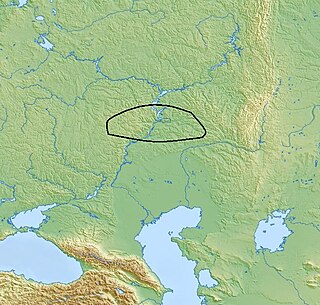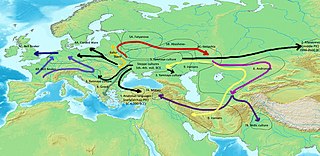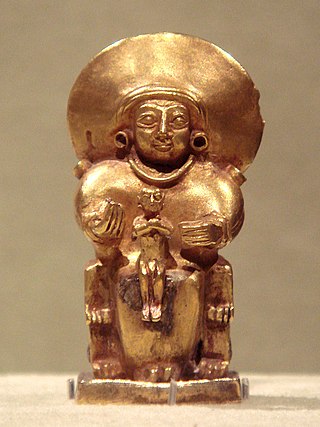Related Research Articles

The Proto-Indo-Europeans are a hypothetical prehistoric ethnolinguistic group of Eurasia who spoke Proto-Indo-European (PIE), the reconstructed common ancestor of the Indo-European language family.

Andrew Colin Renfrew, Baron Renfrew of Kaimsthorn, is a British archaeologist, paleolinguist and Conservative peer noted for his work on radiocarbon dating, the prehistory of languages, archaeogenetics, neuroarchaeology, and the prevention of looting at archaeological sites.

Marija Gimbutas was a Lithuanian archaeologist and anthropologist known for her research into the Neolithic and Bronze Age cultures of "Old Europe" and for her Kurgan hypothesis, which located the Proto-Indo-European homeland in the Pontic Steppe.

Proto-Indo-European mythology is the body of myths and deities associated with the Proto-Indo-Europeans, speakers of the hypothesized Proto-Indo-European language. Although the mythological motifs are not directly attested – since Proto-Indo-European speakers lived in preliterate societies – scholars of comparative mythology have reconstructed details from inherited similarities found among Indo-European languages, based on the assumption that parts of the Proto-Indo-Europeans' original belief systems survived in the daughter traditions.

Proto-Indo-European (PIE) is the reconstructed common ancestor of the Indo-European language family. No direct record of Proto-Indo-European exists; its proposed features have been derived by linguistic reconstruction from documented Indo-European languages.
Old Europe is a term coined by the Lithuanian archaeologist Marija Gimbutas to describe what she perceived as a relatively homogeneous pre-Indo-European Neolithic and Copper Age culture or civilisation in Southeast Europe, centred in the Lower Danube Valley. Old Europe is also referred to in some literature as the Danube civilisation.

Proto-Indo-European society is the reconstructed culture of Proto-Indo-Europeans, the ancient speakers of the Proto-Indo-European language, ancestor of all modern Indo-European languages.

The Kurgan hypothesis is the most widely accepted proposal to identify the Proto-Indo-European homeland from which the Indo-European languages spread out throughout Europe and parts of Asia. It postulates that the people of a Kurgan culture in the Pontic steppe north of the Black Sea were the most likely speakers of the Proto-Indo-European language (PIE). The term is derived from the Turkic word kurgan (курга́н), meaning tumulus or burial mound.

Indo-Iranian peoples, also known as Indo-Iranic peoples by scholars, or as Arya or Aryans from their self-designation, were a group of Indo-European peoples who brought the Indo-Iranian languages, a major branch of the Indo-European language family, to major parts of Eurasia in waves from the first part of the 2nd millennium BC onwards. They eventually branched out into Iranian peoples and Indo-Aryan peoples.
Douglas Quentin Adams is a professor of English at the University of Idaho and an Indo-European comparativist. Adams studied at the University of Chicago, taking his PhD in 1972. He is an expert on Tocharian and a contributor on this subject to the Encyclopædia Britannica.


The Encyclopedia of Indo-European Culture (EIEC) is an encyclopedia of Indo-European studies and the Proto-Indo-Europeans. The encyclopedia was edited by J. P. Mallory and Douglas Q. Adams and published in 1997 by Fitzroy Dearborn. Archaeological articles are written by Mallory, linguistic articles are written by Adams, and include a distinguished Who's Who of 1990s Indo-Europeanists who made contributions as sub-editors. Though it is not a polemic, the work in part extends support to Colin Renfrew's Anatolian hypothesis of Indo-European origins.

The Anatolian hypothesis, also known as the Anatolian theory or the sedentary farmer theory, first developed by British archaeologist Colin Renfrew in 1987, proposes that the dispersal of Proto-Indo-Europeans originated in Neolithic Anatolia. It is the main competitor to the Kurgan hypothesis, or steppe theory, which enjoys more academic favor.

The Proto-Indo-European homeland was the prehistoric linguistic homeland of the Proto-Indo-European language (PIE). From this region, its speakers migrated east and west, and went on to form the proto-communities of the different branches of the Indo-European language family.

Due partly to the fact that this took place before the written record of this region began, there have been a number of theories presented over the years to fill the gap of knowledge about how and why the end of the Cucuteni–Trypillia culture happened. These theories include invasions from various groups of people, a gradual cultural shift as more advanced societies settled in their region, and environmental collapse.

The Indo-European migrations are hypothesized migrations of Proto-Indo-European language (PIE) speakers, and subsequent migrations of people speaking derived Indo-European languages, which took place approx. 4000 to 1000 BCE, potentially explaining how these languages came to be spoken across a large area of Eurasia, spanning from the Indian subcontinent and Iranian plateau to Atlantic Europe.
*Deh₂nu- is a proposed Proto-Indo-European goddess of rivers based on the Vedic goddess Dānu, the Irish goddess Danu, the Welsh goddess Dôn and the names of the rivers Danube, Don, Dnieper, and Dniester. Mallory and Adams however note that while the lexical correspondence is probable, "there is really no evidence for a specific river goddess" in Proto-Indo-European mythology "other than the deification of the concept of ‘river’ in Indic tradition". Some have also proposed the reconstruction of a sea god named *Trih₂tōn based on the Greek god Triton and the Old Irish word trïath, meaning "sea". Mallory and Adams also reject this reconstruction as having no basis, asserting that the "lexical correspondence is only just possible and with no evidence of a cognate sea god in Irish." It is also linked to Ossetian Donbettyr who is offered “three scones with honey” for turning their waterwheels. Donnán of Eigg is considered a possible Christianized version of this deity.
*H₂epom Nepōts is a reconstructed Proto-Indo-European deity who dwells in waters, and whose powers must be ritually gained or controlled by a hero who is the only one able to approach it. The motif may come from swamp gas rising from swamps and igniting. It may come from the high levels of natural gas in Ukraine, the possible Proto-Indo-European homeland.

*Seh₂ul and *Meh₁not are the reconstructed Proto-Indo-European goddess of the Sun and god of the Moon. *Seh₂ul is reconstructed based on the solar deities of the attested Indo-European mythologies, although its gender is disputed, since there are deities of both genders. Likewise, *Meh₁not- is reconstructed based on the lunar deities of the daughter languages, but they differ in regards to their gender.
*H₂n̥gʷʰis is a reconstructed Proto-Indo-European term meaning 'serpent', as well as a possible name for a mythological entity, polycephalous sea serpent or dragon which was slain by a hero named Trito with a help of god Perkʷunos.
References
- 1 2 Prof. Mallory's Academic Homepage at QUB
- 1 2 3 Royal Irish Academy Membership entry
- ↑ Journal of Indo-European Studies
- ↑ Gale. February 21, 2007.
- ↑ J.P. Mallory, "The Indo-European Homeland Problem: The Logic of the Inquiry" Ph.D. dissertation - UCLA. Ann Arbor (Mass): Xerox Microfilms, 1975.
- ↑ Pearson, Robert (2000). "In Memoriam". Journal of Indo-European Studies . 28 (1): 1–2. ProQuest 206746250 . Retrieved 7 September 2020.